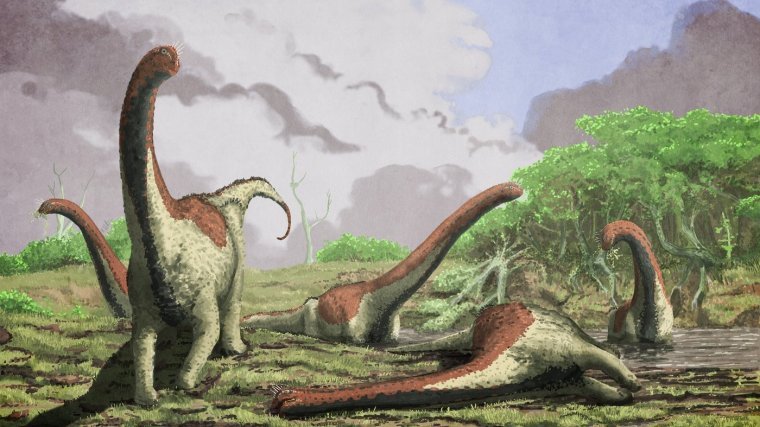| News / Science News |
Paleontologists discover new species of titanosaurian dinosaur in Tanzania
NSF | SEPTEMBER 22, 2014
Paleontologists have identified a new species of titanosaurian, a member of the large-bodied sauropods that thrived during the final period of the dinosaur age, in Tanzania.

This artist's rendition shows the dinosaur's likely paleoenvironment. Image credit: Mark Witton/NSF
Although many fossils of titanosaurians have been discovered around the globe, especially in South America, few have been recovered from the continent of Africa.
The new species, named Rukwatitan bisepultus, was first spotted embedded in a cliff wall in the Rukwa Rift Basin of southwestern Tanzania.
With the help of professional excavators and coal miners, the scientists unearthed vertebrae, ribs, limbs and pelvic bones over the course of several months.
CT scans of the fossils, combined with detailed comparisons with other sauropods, revealed unique features that suggested an animal that was different from previous finds--including those from elsewhere in Africa.
This titanosaur finding is rare for Africa, and will help resolve questions about the distribution and regional characteristics of what would later become one of the largest land animals known. Rukwatitan bisepultus lived approximately 100 million years ago during the middle of the Cretaceous Period.
Titanosaurian sauropods, the group that includes Rukwatitan, were herbivorous dinosaurs known for their iconic large body sizes, long necks and wide stance. Although not among the largest of titanosaurians, Rukwatitan is estimated to have forelimbs reaching 2 meters and may have weighed as much as several elephants.
The dinosaur's bones exhibit similarities with another titanosaurian, Malawisaurus dixeyi, previously recovered in Malawi. But the two dinosaurs are distinctly different from one another, and from titanosaurians known from northern Africa.
The fossils of middle Cretaceous crocodile relatives from the Rukwa Rift Basin also exhibit distinctive features when compared to forms from elsewhere on the continent.
There may have been certain environmental features, such as deserts, large waterways and/or mountain ranges, that would have limited the movement of animals and promoted the evolution of regionally distinct faunas.
In addition to providing new data about species evolution in sub-Saharan Africa, the results contribute to fleshing out the portrait of titanosaurians, which lived in habitats across the globe through the end of the Cretaceous period.
Their rise in diversity came in the wake of the decline of another group of sauropods, the diplodocoids, which include the dinosaur Apatosaurus.
YOU MAY ALSO LIKE





